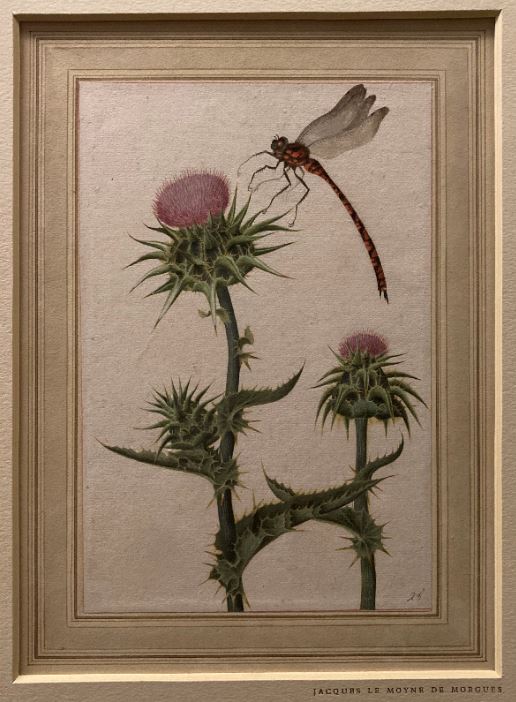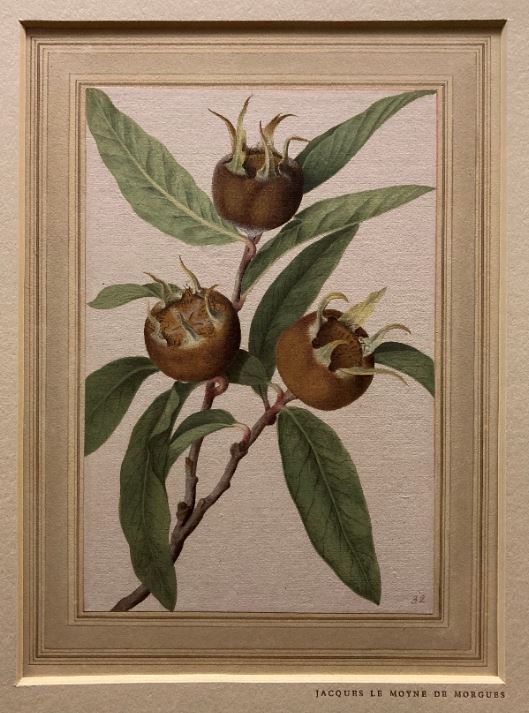As well as its entrance fee-charging blockbuster exhibitions, the British Museum always has 3 or 4 or 5 much smaller, free displays on the go. There are always two or three at the back of the Museum, up on the third floor, in the print rooms. Currently there are no fewer than four separate little exhibitions on display here. This is the first of four reviews of each of them.
The genius of nature botanical drawings by Jacques Le Moyne de Morgues
Le Moyne was one of the most gifted botanical artists of his age. He created remarkable watercolours of plants, flowers, fruit and vegetables.

Milk thistle and dragonfly, probably a mosaic darner by Jacques Le Moyne (1585) Le Moyne often used insects to dramatise portraits of flowers and plants
Biography
Jacques Le Moyne de Morgues lived from about 1533 to 1588. He was raised a Protestant in mostly Catholic France. The Protestant community, during the course of the 16th century, came to be known as ‘Huguenots‘.
As a young man of 30 or so, Le Moyne was chosen to accompany a French expedition to North America in 1564 to 1565, which planned to settle new Protestant colonies in Florida. The mission itself was unsuccessful but Le Moyne’s work as cartographer and artist is thought to have included some of the earliest Western images of the peoples and customs of Florida.
On his return to France he found it engulfed by the Wars of Religion and Protestant Le Moyne fled to London around 1580. He settled in Blackfriars, among a large community of fellow Huguenots.
It was here that he attracted the attention of a fellow explorer of North America, the poet and courtier Sir Walter Raleigh. It was probably Raleigh who introduced Le Moyne to other figures at the Elizabethan court, including Lady Mary Sidney, mother of the poet Sir Philip Sidney.
Apart from their striking verisimilitude, maybe the most striking thing about Le Moyne’s botanical drawings is the lack of fuss. The Renaissance in Britain and France was a period when art overflowed with symbolism, meaning and allegory. Le Moyne seems so fresh and contemporary because he had a much more modern, almost scientific approach. According to the curators this reflected the growing interest in Western Europe in scientific classification and identification.
Although the album’s emphasis is on botanical study, Le Moyne also included numerous studies of insects among his plants. This sheet is the only page from the album devoted to insects and shows, clockwise from top left: a tiger moth, a small tortoiseshell butterfly, a female great green bush-cricket, a caterpillar of the leopard moth, a brown-lipped snail shell, an unidentified snail shell, a sawfly larva, a small grey snail shell, a caterpillar of the swallowtail butterfly, and a caterpillar of the tiger moth.
The images
The British Museum possesses 50 botanical drawings by Le Moyne. They derive from an album of illustrations the Museum bought in 1962. This small display presents a selection of 12 bright and detailed watercolours which look like they were painted yesterday. Isolated against blank backgrounds, surrounded by rectilinear painted frames, these images of plants, flowers and insects have, as the curators point out, the individuality of portraits.

Medlars (Mespilus germanica) by Jacques Le Moyne (1585) Medlars were a popular medieval and Renaissance fruit. Closely related to the apple they were often eaten with cheese or made into jelly. This apparently simple composition in fact allows the fruit to be seen from three different angles.
Le Moyne at the Victoria and Albert Museum
This British Museum display comes just two years after a much more comprehensive exhibition of Le Moyne watercolours which ran at the Victoria and Albert Museum from December 2020 to August 2021.
The V&A owns a different album of Le Moyne’s work. It acquired its album as long ago as 1856, mainly because of the exquisite quality of the 16th century book binding. On the web page below you can view every illustration in the V&A’s album.
Related link
- The genius of nature: botanical drawings by Jacques Le Moyne de Morgues continues in Room 90a at the British Museum until 28 January 2024

